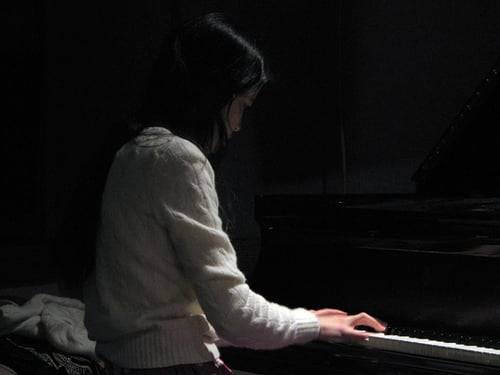#lebrecht
Explore tagged Tumblr posts
Photo

The National Theatre has just announced it will ‘reduce activity’ over the next four years due to ‘financial challenges’. English National Opera is on its final year of funding. The BBC Singers have been abolished. Britten Sinfonia has launched a £1 million appeal to enable it to survive Arts Council cuts. A quarter of the seats in BBC orchestras are to be unwaged. Cities the size of Liverpool, Norwich and Southampton have been left without opera. The post-1945 English artistic renaissance has gone into abrupt reverse, without much political debate. Darkness descends. Discuss.
- Norman Lebrecht
The axe of cultural vandalism is in full swing against anything classical. The BBC is the biggest employer of musicians in the UK, and to lose one in five of their orchestral players will create a black hole for musicians already stymied by visa restrictions and thus wider opportunities traditionally afforded them. The end of the BBC Singers, in particular, is heartbreaking - founded nearly 100 years ago, they have given both comfort and joy to the nation.
Photo: The BBC Singers.
#lebrecht#norman lebrecht#quote#arts#BBC#culture#britain#cuts in funding#funding of the arts#BBC singers#national theatre#britten sinfonia#arts council#BBC orchestras#decline and fall
57 notes
·
View notes
Text

The Maid, Wilhelm August Lebrecht Amberg, 1862
2K notes
·
View notes
Note
I absolutely love your art! 🥰
Also, obligatory art request, as it appears requests are open: could you do one of Larrey or Frederik vi?
If you are in need of references for either, please let me know. I’ve built quite the collection for both. :)
Larrey :D

Blucher Jumpscare ☺️ (Blucher pardoning Larrey after Waterloo)

I was lowkey so close to drawing Lannes's leg on the table, but i ran out of room.
Thank you! Sorry this took so long, I was having rly bad art block, but i'm back now. Also, the urge to yassify them was strong, but i'm seriously trying to get better at drawing men. 💔💔
Btw, i'll probs do a request every couple of weeks or so! Right now they're closed though, but i'll try to get the ones in my inbox all done.
#napoleonic era#napoleonic wars#art#my art#dominique jean larrey#larrey#gebhard lebrecht von blucher#blucher
166 notes
·
View notes
Text

Wilhelm August Lebrecht
23 notes
·
View notes
Text

more highly tonally inappropriate bedazzlement
4 notes
·
View notes
Text



Natalie Rose Lebrecht
1 note
·
View note
Text
0 notes
Text
Norman Lebrecht: Straussov novogodišnji koncert i nacizam
Bečki novogodišnji koncert je možda jedno od poslednjih opuštenih okupljanja svetske televizije. Prvog jutra nove godine, u 11 sati i 15 minuta po centralnoevropskom vremenu, na mestu koje sebe smatra epicentrom Evrope, grupa muškaraca u svečanim odelima penje se na pozornicu Dvorane Bečkog muzičkog društva (Musikverensaal) da bi izvela ritual koji slovi za simbol kulture i tradicije. A koji,…

View On WordPress
0 notes
Audio
Listen/purchase: Prana by Natalie Rose LeBrecht
0 notes
Photo

🪶 Gemeinnützige Naturgeschichte Deutschlands nach allen drey Reichen Leipzig: Bey Siegfried Lebrecht Crusius, 1789-1795.
80 notes
·
View notes
Text
I've got one blurb in here, on the new Natalie Rose LeBrecht. It's good!
Dust Volume Nine, Number Seven

Chuck Johnson
Is it hot where you are? Has it been raining a lot? Is there smoke in the air? It's been the weirdest, most disturbing summer, and you might think it would make music irrelevant. But no, this is Dusted, and we continue to listen and judge and write about records even at the end of times. So here's another Dust. Enjoy. We hope there will be one next month, too, but let's see what happens, eh?
Contributors include Jennifer Kelly, Bryon Hayes, Jonathan Shaw, Chris Liberato, Ian Mathers, Patrick Masterson, Jonathan Shaw, Andrew Forell and Tim Clarke.
Omar Ahmad — Inheritance (AKP)
Inheritance by Omar Ahmad
Omar Ahmad’s music follows dance pulses through thickets of memory. A glitchy beat sinks into slippery textures of synthesizer, piano, strings and field recordings; the music moves but in a haze of memory, as the sounds of women, children and running water flashes and subsides. Omar Ahmad is a Palestinian-American electronic artist and DJ currently based in Brooklyn and in this first full-length, he explores identity (ethnic and otherwise) through a scrim of memory. These glowing ambient compositions don’t hammer the point home—rather they gently suggest and evoke a dual western/Arabic identity. The baby in “Gesso” says “Daddy” in English but is answered in another language. The cut “usra” whose name translates as “home” or “family” incorporates a ululating non-western vocal alongside the pristine electronic modernity of synths. “Sham Oasis” has, perhaps, the most concentrated array of Middle Eastern sounds, a jangle of not-guitars, the thud of hand drums, a shaker, but it also twitches and glitters with space-age electronic sounds. The songs have lovely, idealized, luminous textures that don’t belong, exactly, to any single culture, yet they are warm and beautiful enough to make it feel like home anyway.
Jennifer Kelly
Animal Piss It’s Everywhere — S-T (Half a Million)
Animal Piss, It's Everywhere by Animal Piss, It's Everywhere
This loose and goofy country ramble obsesses over Jesus and intoxicants, sometimes but not always in the same songs. Indeed these bleary sing-alongs seem best suited for Sunday morning with the sun streaming in on the tail end of a one- or two-day bender. They’re exhausted but full of good feeling, played on muscle memory and love of the game. “Jesus Got Under My Skin,” for instance, ramps up the roadhouse boogie in a stunned and stoned narrative about finding one’s savior—and then trying to ditch him. “Naked” slouches and twangs in a righteous chorus of “Naked…ass…man…blues.�� There’s considerable talent on hand, however casually it is deployed, from a confederation of Western Mass freak folk regulars. A guitar-heavy line-up features Anthony Pasquarosa, Clark Griffin (Weeping Bong Band, Pigeons), Shannon Ketch (Bunwinkies) and Andy Goulet on pedal steel (Winter Pills, Lonesome Brothers etc.). Rob Smith from Rhyton and Mouth Painter plays drums and Jim Bliss (of various Matt Valentine projects) sits in on bass. “I’ve found sucksess, sucking at success,” croons the singer, making a point; this band of miscreants achieve their aims without coming within a hundred miles of commercial palatability.
Jennifer Kelly
Aunty Rayzor — “Nina” (Nyege Nyege Tapes)
youtube
Perhaps the hardest song I heard over the last month opens with an almost demented pogoing and a video staring straight at the sun with an airplane’s corpse and a silhouette on the wing fixing her hair before she struts into your life and all over your ears. If you don’t already know Bisola Olungbenga aka Aunty Rayzor, Nyege Nyege Tapes has done a fine job ensuring you’ll want to hear everything the Nigerian has to say after one listen through of “Nina,” the lead single from September’s Viral Wreckage. Veering between red hair and blonde amid rusty MiG-21s, Rayzor takes the hard-nosed rhythm from Berlin-based beatmaker Debmaster — just listen to the way that kick rumbles on the low end — and matches it step for step to powerful effect. You don’t need Nyege Nyege’s effusive description of the forthcoming full-length to gather we have another formidable female rapper waiting in — or is it on? — the wings to embarrass the boys and prolong women’s global chokehold on the genre that little bit longer. Only a fool or an incel could complain.
Patrick Masterson
Aware — Requiem for a Dying Animal (Glacial Movements)
Requiem For A Dying Animal by AWARE
Alexander Glück, who records as Aware, specializes in producing a haunting tributary of ambient sound that aims to cause unease. His music is ghostly, chilling, and morose. It evokes loneliness yet, like most good stories, contains a faint trickle of hope. His compositions encompass vast swathes of tone peppered with microscopic flecks. These resemble large chunks of metamorphic rock that Glück has fused into rich, veiny patterns. These polychromatic constructions tell stories of isolationism and hardship interspersed with hopefulness and joy. They reflect our species’ interconnectedness with a natural world that simultaneously seeks to nurture and destroy us, as we in turn seek to exploit its bounties. With his music, Glück seeks to find an equilibrium, a stalemate between us and our environment. He will likely never solve this riddle, but Requiem for a Dying Animal is a fruitful step on the journey toward his goal.
Bryon Hayes
Blight House — Blight the Way (Syrup Moose Records)
Blight the Way by Blight House
Blight House makes the kind of death metal-infused grindcore that aims for utter absurdity: absurdly heavy riffing; absurdly fast drum-machine blips, blats and thumps; absurdist, so-stupid-they’re clever semiotics. It’s hard not to laugh (or at least ruefully chuckle) at the puns in the band’s name and in the title of this new record. Song titles are even dumber and sometimes even more funny: “Dismembers Only,” “Bible Belt Baby Buffet,” “Walpurgis Date-Night.” And so on. But as is generally the case with records like this, it’s hard to know where the joke ends and the band begins. If it’s all done for laughs, then why is the music executed with such apparent seriousness (n.b., for a less overworked version of a grindy gag act, see this)? And if we’re supposed to hear at least some of Blight House’s stuff with a dash of gravid sincerity, then please, band, send instructions on how to pull off that bit of cognitive jiu-jitsu. Or on second thought, maybe don’t. It’s probably better for everyone involved if we just accept the low-brow yucks to be found in songs like “Acephalophilia III: Hopelessly Headless for You” for what they are, and take the tune at its word. If you think about this sort of edge-lord-adjacent, meme-driven cultural production too hard, you may end up in the writers’ room for Ron DeSantis’s next campaign commercial. Headless and heedless, thoughtless and feckless—blight the way into our collective, idiotic future, dudes.
Jonathan Shaw
Buffalo Nichols — The Fatalist (Fat Possum)
The Fatalist by Buffalo Nichols
Buffalo Nichols’ Carl Nichols has a fine gravelly voice, an unfussy skill with the pick and the slide and the swagger that turns songs of suffering into songs of defiance. In other words, he’s a bluesman of the first order and unusual, these days, in that he’s not 100 years old or a suburban white guy. Yes, Buffalo Nichols is on a mission to reclaim the blues for the folks who invented it—black people—and this very fine album makes a pretty good case for the rightness of his cause. How so? Well, to begin with The Fatalist is mostly acoustic, relying on the speed and accuracy of Nichols fingers rather than a floor sized pedal board; there are no endless wah wah’d solos, no feedback freakery. His vocal delivery matches up, too, quiet but intense, an on-pitch growl that pulls you in and holds you there. There’s a simplicity in the playing and arrangements that underlines the power of these song. Listen, for instance, to the eerie magic of slide, the elemental punch of kick drum on the Blind Willie Nelson cover, “You’re Gonna Need Somebody on Your Bond.” Or the winding melancholy on “The Long Journey Home,” which frolics funereally in banjo and fiddle tones. He brings in the Philadelphia singer and songcatcher Samantha Rise on “This Moment” for a duet, her voice warm and resonant, his hoarse with emotion, a violin twining around the both of them in a dizzy mesh of sounds. A subtle album, but a good one.
Jennifer Kelly
Cyberplasm — First Emanation (Iron Lung)
First Emanation (LUNGS-262) by CYBERPLASM
Electro-punk dissonance melds and mixes it up with anarcho-freak industrial noise on this new EP from Olympia-based Cyberplasm. The band doesn’t seek to exorcize the ghost in the machine so much as conjure it, feed it with nerve impulses harvested from your frontal lobes and then unleash it on our various political and informational systems. Chaos ensues. Maybe it’s liberatory, maybe it just wants to raze all signs of institutional power. Too damn bad if your sense of security or self-worth gets in the way — and in any case, the music is perversely enjoyable. Check out the d-beat scree of “Spit from Fluid” or the foreboding, crust-infused “Second Mind.” The EP’s ten minutes flash by in a series of burned-out synapses and frying amplifiers. Cyberplasm makes underground music that captures the grit and weirdness of lawless subterranean spaces, virtual and material. It’s exciting stuff. It feels dangerous. Punk’s not dead.
Jonathan Shaw
Decoherence — Order (Sentient Ruin Laboratories)
Order by DECOHERENCE
If you have been following Decoherence’s coruscating, cosmic circuit through the 21st century, you won’t find much to be surprised by on Order, the band’s new LP. It’s 40+ minutes of pounding, pyrotechnic industrial metal, thoroughly blackened and shot through with enough harsh noise to burn off your eyebrows. The pace is a little slower, vocalist Derek Jacobsen (who appears on Decoherence releases as Tahazu, an anglicized version of the ancient Sumerian word for battle) sounds like another layer of gristle is occluding his vocal cords, and the compositions of musicians Stroda and Prior are marginally less engaged by melody than many of those on the band’s previous LP, Unitary (2020). If you’re into this sort of thing, none of those small changes is a bad thing. But while Unitary represented a profound development when contrasted with the band’s first several releases, Order feels like a consolidation — a band summing its aesthetics and refining its songwriting sensibility. Which suggests an interesting question: How much order do we want in metal music? This reviewer likes it when Decoherence embraces the chaos denoted by its band name. Check out “An Unconfined System” on this new record. Play it very, very loud. Order? Not so much.
Jonathan Shaw
Drekka—The Water of Life (Orb Tapes)
The Water of Life by Drekka
Michael Anderson, the artist who records as Drekka, made these four long-form meditations for a live performance in Indianapolis in 2015, loosely basing his mix of primitive and electronic sounds on the sci fi classic Dune. All four cuts evolve slowly out of hiss and static (the first one is even called “Stasis and Static”), a buzz like live power wires in the foreground, the faint ghosts of bells, altered choral voices rising up occasionally to mysterious ends. You could, of course, construct an imaginary Dune world out of these sounds, its vast deserts and obliterating sandstorms, its mystic addiction to spice, but it would take some active listening and imagining on your part. The title track assists, somewhat, submerging drips of liquid in the rumble of wind flapping through sails, and the nearly human chants that rise as if from a distance out of the noise. There’s a lot of activity here, a scramble to rattle bits against each other, the click and ching of various percussive elements. And through it comes the hum of dawning revelation, just hovering notes rising, but seeming to reach some inscrutable insight out of the noisy scrum.
Jennifer Kelly
The Finks — Birthdays at Solo Pasta (Milk!)
Birthdays at Solo Pasta by The Finks
Courtney Barnett’s recent announcement that her label Milk! Records will be closing down at the end of the year means that The Finks’ Birthdays at Solo Pasta will be one of the label’s final releases. This feels fitting for a label that has quietly released some understated gems over the years from artists such as Tiny Ruins and Mess Esque. The Finks, led by Oliver Mestitz, create the kind of intimate, loosely woven songs that thrive on the obvious ease between the players, as if you’re listening in to a front-room jam session in which everyone is warmed up and starting to develop their instrumental parts into a lively, organic whole. Mestitz leads the way with his quiet, congested voice, as if he’s perpetually getting over a head-cold, often accompanied by the complementary vocals of Sarah Farquharson. The rhythm section, piano and guitar are wonderfully restrained, the woodwinds muted and sinuous, with everything unfolding patiently. At their best, such as on “Marco Polo” and the instrumental “Ego Slump,” The Finks tap into something truly gorgeous and radiant.
Tim Clarke
Frode Gjerstad / Kalle Moberg / Paal Nilssen-Love — Time Sound Shape (PNL)
Time Sound Shape by Gjerstad / Moberg / Nilssen-Love
If you’ve been tracking Scandinavian free music for the past few decades, you might think you know what record sounds like when you hear that Frode Gjerstad and Paal Nilssen-Love are on it. After all, they’ve been playing together since the latter was a teen and the former was trying to lure promising players into the out-jazz life, and they’ve made a fair number of steaming recordings in that time. But they haven’t made anything quite like Time Sound Shape. Recorded at the Gamle Aker Kirke, Oslo’s oldest edifice, in 2021, it may be completely improvised, but it takes its cues from circumstance, space and opportunity, and those cues point the music in a very different direction. The old stone church’s resonance amplifies Nilssen-Love’s all-gongs set up into a massive sonic presence, and accordionist Kalle Moberg conspires with the percussionist to create a solemnly orchestral breadth of sound. Gjerstad, alternating between alto sax, alto flute and Bb clarinet, sharpens the action with short, anguished cries. This is the biggest sound that three guys can make without the assistance of electricity.
Bill Meyer
Gerrit Hatcher — Solo Five (Kettle Hole)
Solo Five by Gerrit Hatcher
Gerrit Hatcher’s learned well. Instead of waiting for fortune, the Chicago-based tenor saxophonist makes things happen. He plays in town quite often, tours econo and self-releases music on his own label, Kettle Hole Records. The title of this album (a real, glass-mastered CD, unlike the blue-faced disappointments so often sold under that name on Bandcamp these days) attests to his devotion to solo performance. It takes practice as well as physical prowess to command the quivering presence and driving force of his tone, which might remind some of Dave Rempis. Each of the album’s seven tracks makes an assertive statement, but not always a big, loud one; windy textures can be as compelling as rippling notes.
Bill Meyer
James Howard — Peek-a-Boo (Faith and Industry)
Peek-a-Boo by James Howard
James Howard’s debut is all stardust and stopped time. For some reason, I’m reminded of that scene in Buffalo ‘66 where Ben Gazzara, in surreal Sinatra-in-a-tee-shirt mode, croons his father-in-law-y feelings to an entranced, doe-eyed Christina Ricci. Except that Howard’s voice is closer to the dreamy, chill side of Roger Waters (see “St. Tropez'' and “Wots… The Deal”). And his songs are about things like meeting up with your drug dealer on the scenic outskirts of town and raising your children to fear nuclear annihilation. The high point of Peek-a-Boo might be “The Reckoning,” where Howard’s fingers tiptoe up the fretboard like a kid on Christmas Eve on his way to peek at his presents, and cymbals splash like someone on tranquilizers falling into a pool. But really the whole record is a gem and feels like one big, wonderful, floaty, pill-powered dream.
Chris Liberato
Chuck Johnson — Music from Burden of Proof (All Saints)
Music From Burden Of Proof by Chuck Johnson
Chuck Johnson has long been a master of eerie pedal steel atmospherics, building shadowy cloudscapes out of shifting, resonating guitar tone. Here he turns his grasp of sonic mystery to cinematic ends, composing music both guitar-based and not for the HBO series Burden of Proof. If you’re familiar with Johnson’s solo work, the opening “Burden of Proof” will catch you up short with its Bach organ cantata ominous-ness, its densely arranged chamber strings. It sounds not at all like the silvery dream narratives of Balsams or The Cinder Grove; it gathers up in stirring crescendos of emotional turmoil. “The Night of the Disappearance” fits more neatly with what you might have heard before from Johnson. It floats lingering traces of bending guitar sound over a slow lattice of electric keyboard. But setting aside expectations of what Chuck Johnson should or shouldn’t sound like, there is quite a lot to appreciate here: the glittering rhythms and bare-bones bass plunk of “Interrogation,” the swelling synth tones of “Ruth Ann,” the bright cerebral keyboard cadences of “The Note.” Not having seen the show, I can’t tell you how the music works (or doesn’t) to support mood or plot points, but here on the record, it’s subtle and varied, and occasionally, as on “More Surreal” has the slow moving contemplative grace that distinguishes Johnson’s best work. He’s making art and likely getting well paid. Good for him.
Jennifer Kelly
Héctor Lavoe — La Voz (Craft Latino)
youtube
After arriving in New York as a teenager, Puerto Rican singer Héctor Lavoe became a key figure in the popularization of salsa during the 1960s and 1970s. As part of the Fania label roster that included Willie Cólon, Rubén Blades and Celia Cruz, Lavoe released nine albums beginning with his 1975 debut, the aptly named La Voz. Produced and arranged by Cólon, the album foregoes much of the instrumental pyrotechnics of his contemporaries’ records to focus on Lavoe’s voice and improvisational talents. Opener “El Todopoderosa” (The Almighty) features frenetic percussion, piano vamps and blasts of brass which, good as they are, have no chance distracting from Lavoe’s caramel smooth tone and timbre. The clarity of his voice carries the emotional weight of “Un Amor de la Calle” even as the horns weep behind him. On the joyful, faster numbers his call and response with backing vocalists Cólon, Blades and Willie Garcia drive the songs forward but there’s plenty in the background to grab the ears. Witness the off-kilter piano and trumpet solo in “Rompe Saragüey” or the percussion and horn breakdown in “Mi Gente.” Whether you’re a salsa fan or not, this is an opportunity to hear one of the great vocalists in his prime with a killer band and irresistible songs. What’s not to love.
Andrew Forell
Natalie Rose LeBrecht — Holy Prana Open Game (American Dreams)
Holy Prana Open Game by Natalie Rose LeBrecht
It would not be accurate to describe Natalie Rose LeBrecht’s new record as a mix between La Monte Young/Marian Zazeela’s (who she’s studied with and assisted) cosmic minimalism and the Dirty Three’s more spacey, searching efforts (that trio’s Mick Turner and Jim White both play on Holy Prana Open Game), but even in its inadequacy the comparison points towards the kind of rarified air the record is floating amidst. It’s kind of wild to remember that “Amok” here is a radically transformed (one might even say, ahem, improved) cover of the Atoms For Peace song, it’s so of a piece with the other five pieces that make up the album. Whether it’s the more open excursions of “Open” and “Prana” or the gentle lilt of the opening “Home,” this suite soars into inner space immediately and rests there contentedly.
Ian Mathers
Gabe ‘Nandez — “Louis XIV” (POW Recordings)
youtube
Anyone paying attention to Jeff Weiss’ POW Recordings has been able to surmise how enthusiastic the label head has been about the hushed husk of New Yorker Gabe ‘Nandez, and Gabe’s returned the favor in kind with polyglot explorations of the inter- and intrapersonal alike, most recently on April’s Pangea, plus a feature alongside fellow East Coast tome spitter Billy Woods on last year’s Aethiopes. The one-off “Louis XIV” finds Gabe talking kingly killings and heartbreak over a sublimely paired beat from Tel Aviv producer Argov (he of “Venus in Mercury” that preceded this) and kitted in a Burberry coat amid London’s Abney Park cemetery. A low-slung, high-intensity performance, “Louis XIV” is self-evident, a perfect portrait of what makes ‘Nandez so lethal (and appealing) as a rapper. Anyone with an affinity for bars ought to appreciate it.
Patrick Masterson
Jim O’Rourke — Hands That Bind OST (Drag City)
Hands That Bind (Original Motion Picture Soundtrack) by Jim O'Rourke
Any word of a new Jim O’Rourke release is justifiably greeted with excitement, especially when that release is via Drag City. However, Hands That Bind isn’t a continuation of the glorious singer-songwriter fare O’Rourke has perfected on albums such as Eureka, Insignificance and Simple Songs, but rather the soundtrack to a new film by director Kyle Armstrong. The instrumental atmosphere is aligned with many of O’Rourke’s Steamroom explorations, which he’s made available in a steady stream via Bandcamp: slow, sparse, mostly abstract synthesizer soundscapes. The difference here, given O’Rourke is responding to a visual medium, is deeper grounding in the creation of an immediate evocative mood. Shimmering synth textures evoke the chittering of crickets and wide-open expanses of countryside, punctuated by percussion and the reassuring thrum of upright bass. Then, suddenly, a detuned piano or dulcimer will cut through the mix, raising an eyebrow of concern, as if uncertainty is looming on the horizon. The drama of this simple juxtaposition creates an addictive tension that sustains this elegant suite’s runtime.
Tim Clarke
Rat Heart — “Flashing Lights Freestyle” (Shotta Tapes)
Rat Heart - Flashing Lights Freestyle by Shotta Tapes
One of Kanye’s most indelible beats is herewith given a kind of Jai Paul-like treatment via Mancunian Tom Boogizm, who runs the Shotta Tapes label that’s known best for the free-for-all experiments of his increasingly visible Rat Heart alias. We’re a far cry from Northern Luv Songs 4 Wen Ur Life's a Mess, obviously, which threw all manner of spaced-out, instrumental guitar hypnotics at the wall only to see it all stick in a manner most Dusted faithful would find familiar — but this isn’t a total left turn for Tom given we’ve also seen stuff like the Actress-esque 'A Blues' come out in the last year. If you don’t know where to start with him, this serves as a good point of entry for his more beat-driven material, the vocals submerged just that little bit too much beneath the fluorescent, once-ubiquitous backing beat of the Graduation staple. Nobody’s asking for a return to 2007 (that I know of, anyway), but it’s enough for a moment to remember the music once outshone the hubris of its creator. Some of us might call that moment simpler.
Patrick Masterson
La Sécurité — Stay Safe! (Mothland)
youtube
Montreal quintet La Sécurité combine insouciant new wave and funk driven post punk on their debut album Stay Safe! It’s a lane that’s been driven before by bands like Romeo Void and Au Pairs, but they bring an infectious energy to bear. Singing in French and English, lead vocalist Éliane Viens-Synnott moves from the ironic detachment of Debora Lyall to indignant recrimination, shaping her voice to inhabit each song. Atop Kenneth Smith’s propulsive drums and Félix Bélisle’s elastic bass lines, guitarists Melissa Di Menna and Laurence Anne Charest-Gagné add chunky chords and sibilant solos. Although you can spend time picking the influences, the songs are uniformly good. The dispassionate sprechgesang of “Le Kick” with its motorik drums and Au Pairs guitar licks, the mocking tone of the Devo like “Waiting For Kenny,” the groove of “Serpent” which sounds like an amalgam of “Snakes Crawl” and “Too Many Creeps.” The rhythms are tight, the guitars slash and chime in equal measure, the quintet all contribute synths, percussion and backing vocals to their stories of toxic men, relationship ups and downs and daily grind of existence.
Andrew Forell
Jumping Back Slash, Būjin — “Order of Change” (Future Bounce Ltd.)
youtube
Would you believe this started as a piano-based folk ballad? Maybe not if you only heard the first half of the first single from a promised forthcoming album due in November. But what originated as a song with a “folklike Kate Bush flavor to it” morphed into a Janus-faced split of a dancefloor-filling first half that runs Brit-turned-South African Jumping Back Slash’s bass-heavy club deconstruction right through Cape Town native Būjin’s delicate but firm vocal before turning into a lush, orchestral outro much closer in spirit to the original idea. The balance works both ways for Būjin, who tightropes across the transition clear to the other side. What else this LP has in store remains to be seen, but it’s a promising first dispatch for those who err on the side of futuristic pop sounds.
Patrick Masterson
Whose Rules — Hasler (777 Rules)
Hasler by Whose Rules
If you’ve got any sort of weakness for airy, breathless, pristine indie pop, may I suggest Whose Rules, the solo endeavor from a busy Norwegian producer named Marius Elfstedt. This first album, Hasler, touches ever so lightly on sonic territories staked out by Elliott Smith: a wistful tenor warble wrapped around softly inevitable tunes. You might even catch a whiff of the Sea and Cake’s breezy artfulness. Yet while the songs aren’t weighted down, they’re not exactly scrubbed bare either. Elfstedt’s producer background shows through in shifting, transparencies of overlaid sound: guitars, synths, percussion frame delicate melodies but don’t overwhelm them. The music wafts by in a flavored cloud, but there’s a good deal of nourishment in its ethereal mix. I like “Stone” with its scrabbly guitars, its rainy/sunny moods, its sudden swells of synth that could easily be horn lines. There’s a bigger, brassier song in here somewhere, but for now it’s hiding shyly, reticently in a private corner of Elfstedt’s imagination.
Jennifer Kelly
4 notes
·
View notes
Photo




Nonfiction Recommendations: Jewish American Heritage Month
Black, White and Jewish by Rebecca Walker
The Civil Rights movement brought author Alice Walker and lawyer Mel Leventhal together, and in 1969 their daughter, Rebecca, was born. Some saw this unusual copper-colored girl as an outrage or an oddity; others viewed her as a symbol of harmony, a triumph of love over hate. But after her parents divorced, leaving her a lonely only child ferrying between two worlds that only seemed to grow further apart, Rebecca was no longer sure what she represented. In this book, Rebecca Leventhal Walker attempts to define herself as a soul instead of a symbol—and offers a new look at the challenge of personal identity, in a story at once strikingly unique and truly universal.
Bad Jews by Emily Tamkin
What does it mean to be a Bad Jew? Many Jews use the term “Bad Jew” as a weapon against other members of the community or even against themselves. You can be called a Bad Jew if you don’t keep kosher; if you only go to temple on Yom Kippur; if you don’t attend or send your children to Hebrew school; if you enjoy Christmas music; if your partner isn’t Jewish; if you don’t call your mother often enough. The list is endless.
In Bad Jews, Emily Tamkin argues that perhaps there is no answer to this timeless question at all. Throughout American history, Jewish identities have evolved and transformed in a variety of ways. American Jewish history is full of discussions and debates and hand wringing over who is Jewish, how to be Jewish, and what it means to be Jewish. In this book, Emily Tamkin examines the last 100 years of American Jewish politics, culture, identities, and arguments. Drawing on over 150 interviews, she tracks the evolution of Jewishness throughout American history, and explores many of the evolving and conflicting Jewish positions on assimilation; race; Zionism and Israel; affluence and poverty, philanthropy, finance, politics; and social justice. From this complex and nuanced history, Tamkin pinpoints perhaps the one truth about American Jewish It is always changing.
Genius & Anxiety by Norman Lebrecht
In a hundred-year period, a handful of men and women changed the way we see the world. Many of them are well known—Marx, Freud, Proust, Einstein, Kafka. Others have vanished from collective memory despite their enduring importance in our daily lives. Without Karl Landsteiner, for instance, there would be no blood transfusions or major surgery. Without Paul Ehrlich, no chemotherapy. Without Siegfried Marcus, no motor car. Without Rosalind Franklin, genetic science would look very different. Without Fritz Haber, there would not be enough food to sustain life on earth.
What do these visionaries have in common? They all had Jewish origins. They all had a gift for thinking in wholly original, even earth-shattering ways. In 1847 the Jewish people made up less than 0.25% of the world’s population, and yet they saw what others could not. How? Why?
Norman Lebrecht has devoted half of his life to pondering and researching the mindset of the Jewish intellectuals, writers, scientists, and thinkers who turned the tides of history and shaped the world today as we know it. In Genius & Anxiety, Lebrecht begins with the Communist Manifesto in 1847 and ends in 1947, when Israel was founded. This robust, magnificent volume, beautifully designed, is an urgent and necessary celebration of Jewish genius and contribution.
People Love Dead Jews by Dara Horn
Renowned and beloved as a prizewinning novelist, Dara Horn has also been publishing penetrating essays since she was a teenager. Often asked by major publications to write on subjects related to Jewish culture—and increasingly in response to a recent wave of deadly antisemitic attacks—Horn was troubled to realize what all of these assignments had in common: she was being asked to write about dead Jews, never about living ones. In these essays, Horn reflects on subjects as far-flung as the international veneration of Anne Frank, the mythology that Jewish family names were changed at Ellis Island, the blockbuster traveling exhibition Auschwitz, the marketing of the Jewish history of Harbin, China, and the little-known life of the "righteous Gentile" Varian Fry. Throughout, she challenges us to confront the reasons why there might be so much fascination with Jewish deaths, and so little respect for Jewish lives unfolding in the present.
Horn draws upon her travels, her research, and also her own family life—trying to explain Shakespeare’s Shylock to a curious ten-year-old, her anger when swastikas are drawn on desks in her children’s school, the profound perspective offered by traditional religious practice and study—to assert the vitality, complexity, and depth of Jewish life against an antisemitism that, far from being disarmed by the mantra of "Never forget," is on the rise. As Horn explores the (not so) shocking attacks on the American Jewish community in recent years, she reveals the subtler dehumanization built into the public piety that surrounds the Jewish past—making the radical argument that the benign reverence we give to past horrors is itself a profound affront to human dignity.
#jewish american heritage month#jewish heritage#judaism#nonfiction#nonfiction books#Nonfiction Reading#history#Reading Recs#reading recommendations#Book Recommendations#book recs#TBR pile#tbr#tbrpile#to read#Want To Read#Booklr#book tumblr#book blog#library blog
44 notes
·
View notes
Text

Miles Davis and Wayne Shorter in Berlin Germany 1964,
Photo © JazzSign/Lebrecht Music & Arts/Corbis
https://www.facebook.com/TheWorldOfJazz
39 notes
·
View notes
Text
Why Passover Is One of Judaism’s (of The Real Jews Not of The Zionist 🐷 🐖 🐗 🐖) Most Important Holidays
Passover, one of Judaism's most revered holidays, honors the ancient Israelites' freedom from slavery in Egypt.
— By Erin Blakemore | April 15, 2024

Rabbi Pinsk Karlin and other ultra-Orthodox Jews collect water from a spring to make matzoh, a traditional handmade unleavened bread for Passover, at a mountain spring in the outskirts of Jerusalem. Jews are forbidden to eat leavened foodstuffs during Passover. Photograph By Ariel Schalit, AP
As the days brighten and spring kicks into full swing, Jews all over the world prepare for Passover, a weeklong holiday that is one of Judaism’s most widely celebrated and most important observances. Also known by its Hebrew name Pesach, Passover combines millennia of religious traditions—and it’s about much more than matzoh and gefilte fish.
The Origins of Passover
The story of Passover can be found in the book of Exodus in the Hebrew Bible, which relates the enslavement of the Israelites and their subsequent escape from ancient Egypt.
Fearing that the Israelites will outnumber his people, the Egyptian Pharaoh enslaves them and orders every newly born Jewish son murdered. One son is Moses, whose birth has been foretold as the savior of the Israelites. He is saved and raised by the pharaoh’s daughter.

William Brassey Hole's "The Passage of the Red Sea" depicts the biblical story from Exodus in which God, acting through Moses, parts the Red Sea to allow the Israelites to cross to safety out of Egypt. Lebrecht History/Bridgeman Images
In adulthood, God speaks to Moses, urging him to tell Pharaoh to let his people go. But the pharaoh refuses. In return, God brings ten consecutive plagues down on Egypt (think: pestilence, swarms of locusts, and water turning to blood), but spares the Israelites.
During the final plague, an avenging angel goes door to door in Egypt, smiting every household’s firstborn son. God has other plans for the Israelites, instructing Moses to tell them to slaughter a lamb, then brush its blood on the sides and tops of their doorframes so that the avenging angel will “pass over.” Then they are to eat the sacrificial lamb with bitter herbs and unleavened—without yeast—bread. This is the last straw for Pharaoh, who frees the Israelites and banishes them from Egypt.
What’s on a Seder Plate
Modern Passover celebrations commemorate and even reenact many of the biblical events. The seder (“order”), the ritual meal that is the centerpiece of Passover celebrations, incorporates foods that represent elements of the story.
Bitter herbs (often lettuce and horseradish) stand for the bitterness of slavery. A roasted shank bone commemorates the sacrificial lamb. An egg has multiple interpretations: Some hold that it stands for new life, and others see it as standing for the Jewish people’s mourning over the struggles that awaited them in exile. Vegetables are dipped into saltwater representing the tears of the enslaved Israelites. Haroset, a sweet paste made of apples, wine, and walnuts or dried fruits, represents the mortar the enslaved Israelites used to build Egypt’s store cities.

The centerpiece of modern Passover celebrations is the seder, a ritual meal commemorating the Israelites' escape from enslavement in Egypt. The dinner involves readings from a manuscript called the Haggadah. The Sarajevo Haggadah, pictured here, is one of the oldest, dating back to the 14th century. Photograph By Zev Radovan, Bridgeman Images
During a traditional seder, participants eat unleavened bread, or matzoh, three times, and drink wine four times. They read from a Haggadah, a guide to the rite, hear the story of Passover, and answer four questions about the purpose of their meal. Children get involved, too, and search for an afikomen, a piece of broken matzoh, that has been hidden in the home. Every seder is different, and is governed by community and family traditions.
How is Passover Celebrated
Passover observances vary in and outside of Israel. The holiday lasts one week in Israel and eight days in the rest of the world, in commemoration of the week in which the Israelites were pursued by the Egyptians as they went into exile.
During those days, many Jews refrain from eating leavened bread; some also abstain from work during the last two days of Passover and attend special services before and during Passover week. Orthodox and Conservative Jews outside of Israel participate in two seders; Reform Jews and those inside Israel only celebrate one.
But no matter where or how you observe Passover, its celebrations underscore powerful themes of strength, hope, and triumph over adversity and anti-Semitism.
A Brief History of Matzoh: 'It's Not Supposed To Taste Good'
Restrictions around matzoh are meaningful and refreshing to many: here’s why.
— By April Fulton | Published: May 17, 2023

Matzoh is central to Passover, when Jews are prohibited from eating leavened food. Matzoh must be baked within around 18 minutes to prevent rising. Photograph By Becky Harlan, National Geographic Image Collection
Matzoh, known by Jews worldwide as “the bread of affliction,” is a cracker-like food made of flour and water eaten to commemorate the Hebrew slaves’ exodus from Egypt. The bland crisp takes the place of bread for the eight days of Passover.
While the aforementioned affliction may have changed over the years from one of desert-trekking deprivation to palatal hardship, most Hebrew scholars agree on one thing: It is not supposed to taste good.
Yet, for at least the first day of the holiday, many people actually crave it. Why?
For answers to this burning question about the nature of matzoh, we turn to Michael Wex, the author of Rhapsody in Schmaltz: Yiddish Food and Why We Can’t Stop Eating It.
“Now we eat it because we don’t have to eat it,” he says. In other words, because God’s chosen people have other choices the rest of the year, they look forward to eating matzoh to commemorate when Jews had no other choice but matzoh. And when it pops up in the grocery stores, many non-Jews pick up a few boxes, too.
According to the Hebrew bible, after a long protracted battle that featured God-directed plagues like frogs, boils, locusts, and the slaughter of first-born sons, the Egyptians freed the Hebrew slaves. The Jews left hastily, without time to let their bread rise. God basically tells them to take their dough and go, and that they’ll be cut off from Him if they eat anything leavened, i.e. yeasted or risen, for seven days. Hence—the first matzoh—the “roadside fast food from the ancient near East,” as Wex calls it.
The Passover seder dinner is centered around the matzoh, and is a virtual reenactment of the story of Exodus. In our family, the long, ritualistic dinner is frequently summed up for uninitiated guests in this way: “They tried to kill us, we’re still here, let’s eat.”
And so we eat matzoh, both plain and in forms that attempt to make it more palatable by adding salt and egg to create dumpling-like matzoh balls for chicken soup; or by topping it with sugary jam. Kids particularly love chocolate-covered matzoh for dessert.
Yes, there are other foods served at Passover, much of which varies according to where you’re from or what your grandma always made. Ours almost always includes brisket, kugel (a kind of casserole), and some kind of token vegetable. But matzoh is front and center.
There are strict specifications for making matzoh, of course. (Judaism is all about rules.) First of all, you only have 18 minutes from adding water to the flour to bake it. That’s the amount of time scholars say you have before the dough starts to rise, which would make the whole business un-kosher for Passover.
The result is a thin, flat plate-sized wafer “without even a kiss of salt,” Wex says. The first matzoh were probably round. The advent of machine-made matzoh led to the rise of the easier to pack and stack square marvel many of us know today. But the flavor? Pretty much the same, to my taste.

Traditional matzoh is broken ceremoniously at the beginning of the Jewish Passover seder.
There are also prescriptions for the matzoh to be harvested at a certain time of day and when it is dry enough, as prescribed by a rabbi, to prevent fermentation (i.e. leavening.) Dan Barber, back-to-the-land advocate and chef, made the case that the result of this close supervision may mean the wheat harvested is of higher quality, and therefore Jewish law may actually make food taste better.
But Wex and other scholars say this is beside the point. From Rhapsody in Schmaltz:
“There are those who say that God gave us cardboard so that we could describe the taste of matzoh, but taste is what matzoh is not about...Matzoh doesn’t need to be good, it only needs to be there—inside of 18 minutes. Or 22, according to some authorities; however long it took to walk to Tiberias from Migdal Nunia, the probable home of Mary Magdalene—a single Roman mile.”
Wex argues that the creation of Jewish dietary laws, particularly as they relate to matzoh, create for Jews a sense of otherness. While rules like no pork and no cheeseburgers may seem oppressive these days, in ancient times, it gave the Jewish people a new way of thinking. Once they were no longer slaves, they were “free to act in ways that have nothing to do with Egypt,” including, throwing out all their learned notions of what to eat.
There are entire Jewish communities, of course, who follow the ancient prescriptions to the letter for Passover and beyond. But do modern Jews still need to follow these ancient laws? Wex says you can have a strong Jewish conscience and not follow the dietary laws, but you should understand them “if you want your religion to stick around.”
The Very Ancient Passover of One of the Smallest Religions in the World
For thousands of years, the tiny Samaritan community has observed Passover according to its biblical laws.
— By Kristin Romey | Published: April 19, 2019

Samaritan boys wrangle a goat towards the sacrifice grounds on Passover eve in Kiryat Luza, West Bank. Photograph By Simon Norfolk
Samaritans are one of the world’s smallest religious groups, claiming descent from three of the 12 tribes of ancient Israel. They consider themselves the true observants of Israelite religion, and view Judaism as a religious practice corrupted during the Babylonian exile. This separation is clearly delineated in the geography of the Holy Land: While Mount Moriah in Jerusalem is where the Jewish Temple was decreed by God, the Samaritans followed the command of that same God and built their temple on the peak of Mount Gerizim, some 30 miles to the north.

Samaritan elders gather during the Passover eve sacrifice. There are a little more than 800 people in the Samaritan community, almost evenly divided between the Tel Aviv suburb of Holon and the West Bank village of Kiryat Luza. Photograph By Simon Norfolk
Today, Mount Gerizim, at an elevation of almost 3,000 feet, is one of the highest points in the Palestinian territories, and commands a sweeping view of the bustling city of Nablus and the West Bank villages that surround it. On its ridge is the village of Kiryat Luza, where, on the eve of each Passover, the roughly 800 members of the Samaritan community gather to pray and observe their liberation from slavery in Egypt.

Left: A young Samaritan boy wears a distinctive red hat known as a tarbush. Right: worshipers and visitors mingle as the sacrificed goats roast for hours in large pit ovens. Photographs By Simon Norfolk
In remembrance of that event, the Samaritans follow the Torah mandate that a sheep or lamb be sacrificed on Passover eve and consumed before dawn of the next day. In Kiryat Luza, this is a communal event, in which prayers are recited and dozens of animals are dispatched simultaneously by men dressed in all white and then roasted in enormous earthen pits. In the hours after midnight, the meat is heaped on trays alongside bundles of bitter herbs and dished out in a celebratory community gathering under the stars.

Following a group countdown, these Samaritan men will simultaneously plunge their skinned and dressed offerings into the blazing earthen oven. All of the meat must be eaten or burned before the sun rises on the first day of Passover. Photograph By Alessio Romenzi
Seven days later, the Samaritan community marks the end of Passover with a more solemn event. Once again under the stars just a few hours before dawn, the white-robed men of the community gather in front of their small synagogue, young sons beside them, rubbing the sleep from their eyes.
Led by their head priest cradling a silver Torah case, the men ascend Mount Gerizim in the darkness, climbing stone steps past the remains of their temple, destroyed by the Hasmoneans in the early second century B.C., and the rubble of a church built on their sacred peak by the Byzantine emperor Zeno some 600 years later. At points along the ascent, they stop to pray and then continue on as the dawn sky turns periwinkle and the paper-thin blossoms of scarlet poppies begin to unfurl.

On the seventh day of Passover, white-robed Samaritan men climb to the peak of Mount Gerizim, where their ancient temple once stood. Photograph By Simon Norfolk
The procession ends near a stone slab believed by Samaritans to be the site where Abraham intended to sacrifice his son Isaac. The sun breaks above the horizon and the high priest raises the shining Torah case above his head as he concludes the group prayer. It’s a spring day on Mount Gerizim, and once again this tiny community has gathered together to fulfill its sacred duties before God.
#Judaism ✡️ | Holidays | Bible | Traditions | Diseases#History | Culture#Civilization#People#Water 💦#Ancient Egypt 🇪🇬#Religion#Baked Goods#Food 🍲🍱🥘
2 notes
·
View notes
Text





the ever-incredible natalie rose lebrecht
6 notes
·
View notes
Text
Greenpot Bluepot - Shut Up: The Paradox (2001)
0 notes